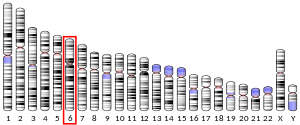RSPO3
R-spondin-3 is a protein that in humans is encoded by the RSPO3 gene.[5][6][7]
Function
This gene encodes a member of the thrombospondin type 1 repeat supergene family. In addition, the protein contains a furin-like cysteine-rich region. Furin-like repeat domains have been found in a variety of eukaryotic proteins involved in the mechanism of signal transduction by receptor tyrosine kinases.[7]
During embryonic development, RSPO3 is expressed in the tail bud and the posterior presomitic mesoderm of the embryo. In tissue engineering, R-spondin 3 has been used to differentiate pluripotent stem cells into paraxial mesoderm progenitors[8]
References
- 1 2 3 GRCh38: Ensembl release 89: ENSG00000146374 - Ensembl, May 2017
- 1 2 3 GRCm38: Ensembl release 89: ENSMUSG00000019880 - Ensembl, May 2017
- ↑ "Human PubMed Reference:".
- ↑ "Mouse PubMed Reference:".
- ↑ Adams JC, Tucker RP (Jun 2000). "The thrombospondin type 1 repeat (TSR) superfamily: diverse proteins with related roles in neuronal development". Developmental Dynamics. 218 (2): 280–99. PMID 10842357. doi:10.1002/(SICI)1097-0177(200006)218:2<280::AID-DVDY4>3.0.CO;2-0.
- ↑ Kazanskaya O, Glinka A, del Barco Barrantes I, Stannek P, Niehrs C, Wu W (Oct 2004). "R-Spondin2 is a secreted activator of Wnt/beta-catenin signaling and is required for Xenopus myogenesis". Developmental Cell. 7 (4): 525–34. PMID 15469841. doi:10.1016/j.devcel.2004.07.019.
- 1 2 "Entrez Gene: RSPO3 R-spondin 3 homolog (Xenopus laevis)".
- ↑ Chal J, Oginuma M, Al Tanoury Z, Gobert B, Sumara O, Hick A, Bousson F, Zidouni Y, Mursch C, Moncuquet P, Tassy O, Vincent S, Miyanari A, Bera A, Garnier JM, Guevara G, Hestin M, Kennedy L, Hayashi S, Drayton B, Cherrier T, Gayraud-Morel B, Gussoni E, Relaix F, Tajbakhsh S, Pourquié O (Sep 2015). "Differentiation of pluripotent stem cells to muscle fiber to model Duchenne muscular dystrophy". Nature Biotechnology. 33 (9): 962–9. PMID 26237517. doi:10.1038/nbt.3297.

Further reading
- Kim KA, Zhao J, Andarmani S, Kakitani M, Oshima T, Binnerts ME, Abo A, Tomizuka K, Funk WD (Jan 2006). "R-Spondin proteins: a novel link to beta-catenin activation". Cell Cycle. 5 (1): 23–6. PMID 16357527. doi:10.4161/cc.5.1.2305.
- Hannah BL, Misenheimer TM, Annis DS, Mosher DF (Mar 2003). "A polymorphism in thrombospondin-1 associated with familial premature coronary heart disease causes a local change in conformation of the Ca2+-binding repeats". The Journal of Biological Chemistry. 278 (11): 8929–34. PMID 12643280. doi:10.1074/jbc.M211185200.
- Chen JZ, Wang S, Tang R, Yang QS, Zhao E, Chao Y, Ying K, Xie Y, Mao YM (Sep 2002). "Cloning and identification of a cDNA that encodes a novel human protein with thrombospondin type I repeat domain, hPWTSR". Molecular Biology Reports. 29 (3): 287–92. PMID 12463421. doi:10.1023/A:1020479301379.
This article is issued from
Wikipedia.
The text is licensed under Creative Commons - Attribution - Sharealike.
Additional terms may apply for the media files.



